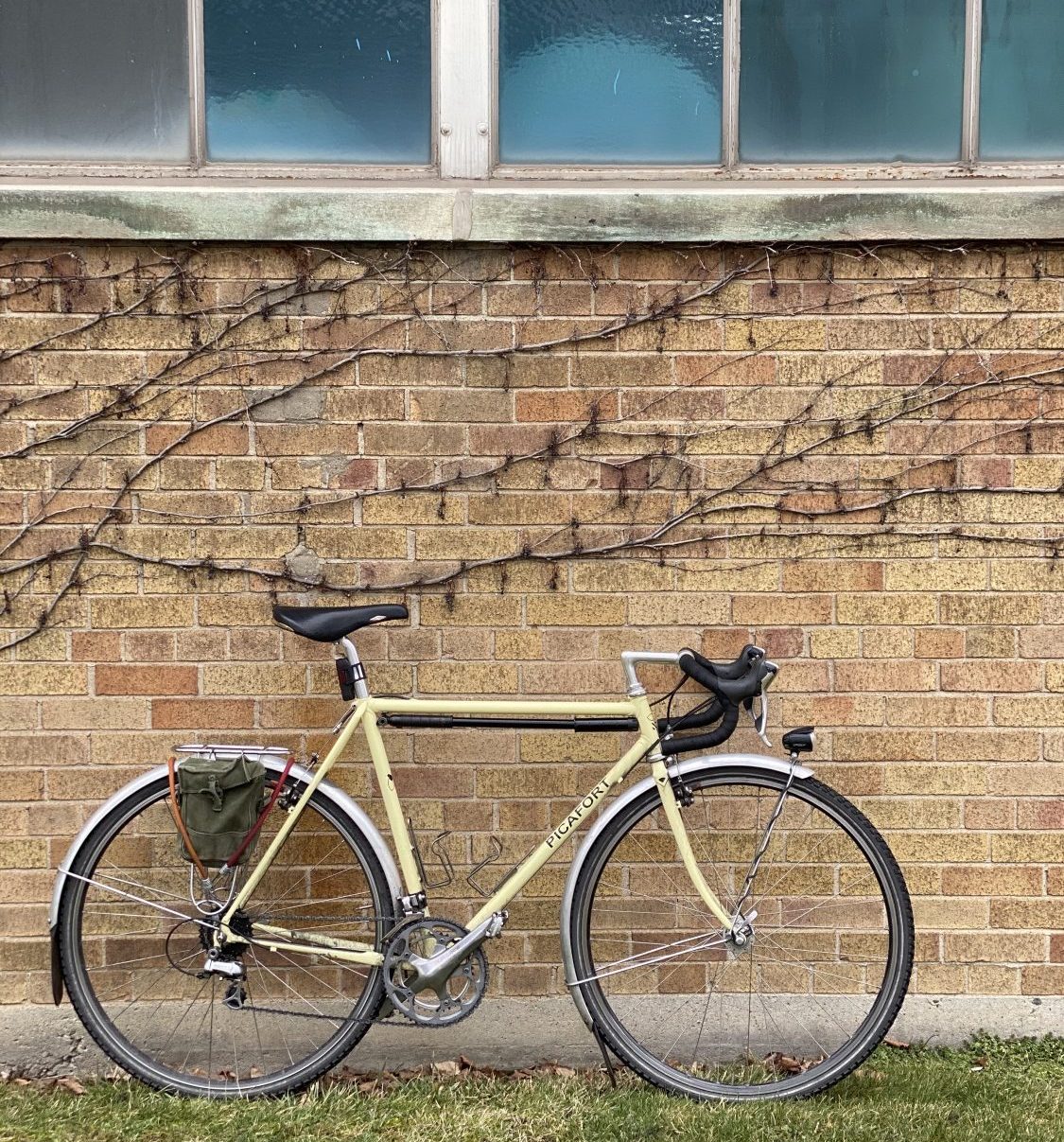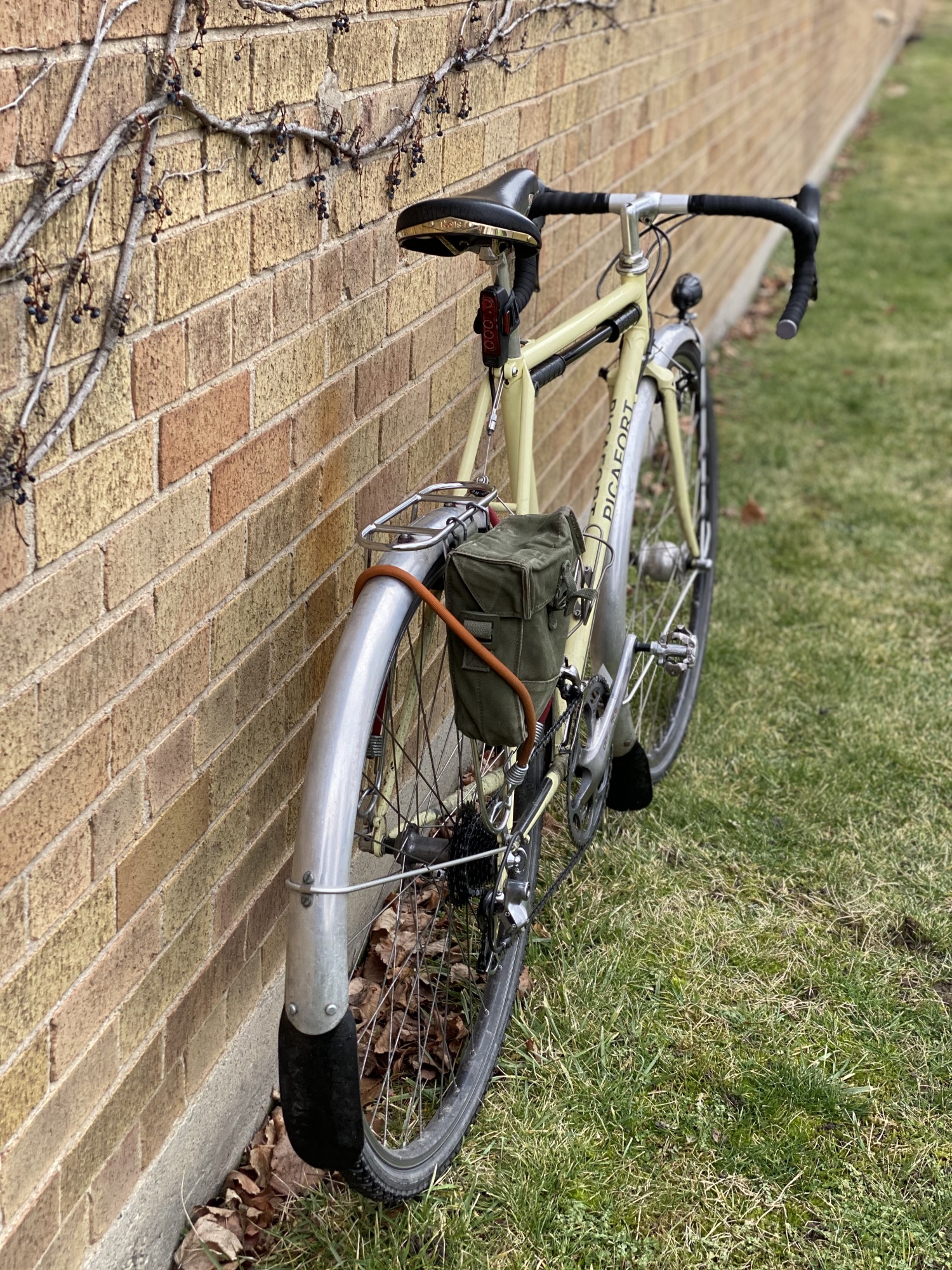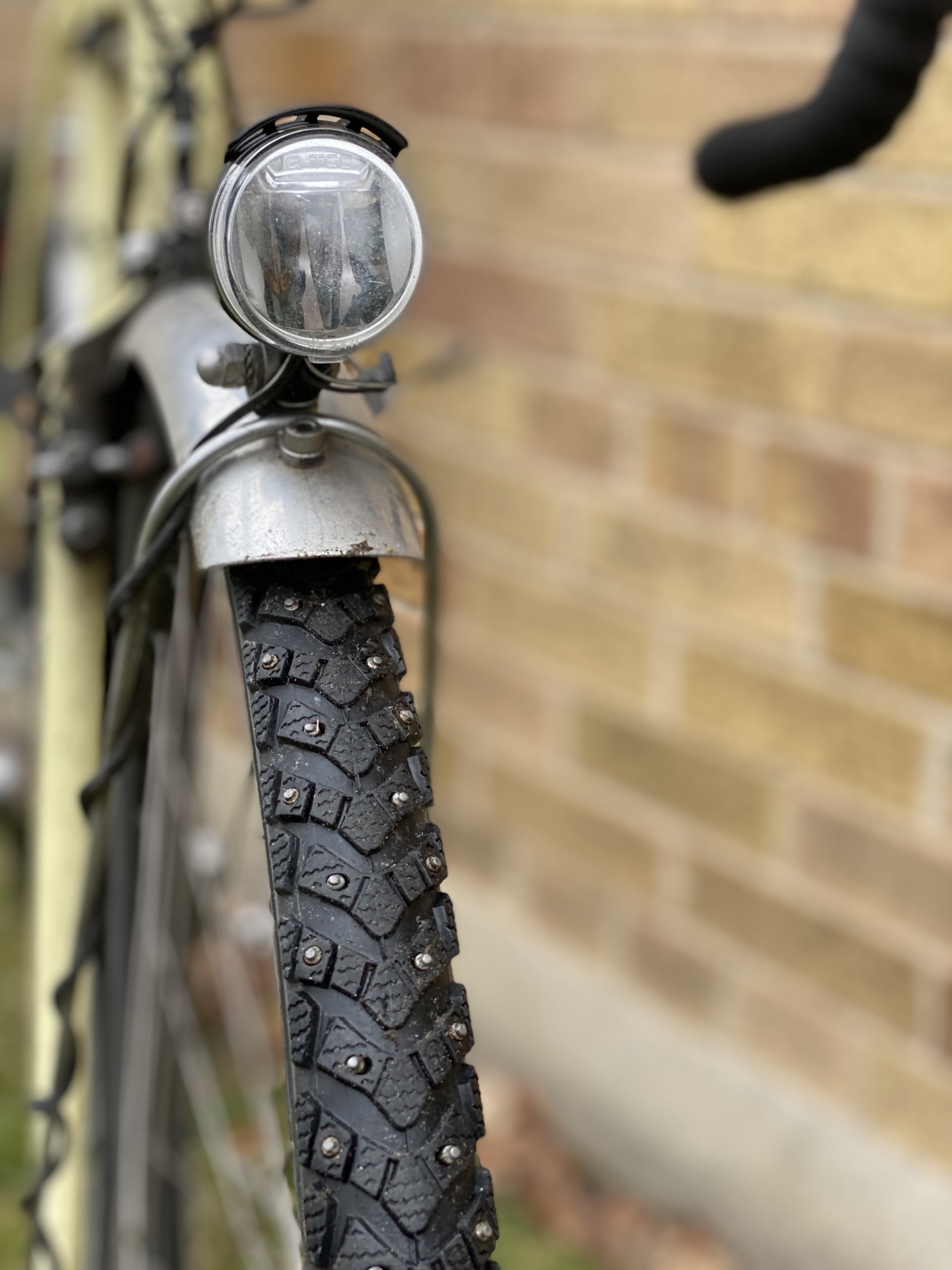Mariposa Bicycles painter and mechanic, Peter Morse, has ridden to work every day over the last five years, which in Toronto, where the winters are tough, is an accomplishment. He arrives at work with a smile even when there is a foot of snow or it -20 Celsius. He’s written a few tips on how to ride comfortably outdoors when it’s icy, snowy, cold and wet.
By Peter Morse
In thinking about winter riding and writing this article, I have realized that there are just too many winter riding tips to put on one page. So, I’ll start us off by sharing my knowledge about winter footwear and fenders (mud-guards). I’ve learned over the years, mostly through hard lessons, that these two are the most crucial to winter riding comfort and are intimately linked.
Pete’s winter commuter, which he built several years ago in the Mariposa workshop, was designed to accept 700C x 35mm Schwalbe Marathon Plus Winter spiked tires, fenders, a small carrier for his lunch, a frame pump, hub generated dynamo lights and full size Honjo Alloy fenders.
Generally, I only ride my fender bike(s) once the snow flies and the salt trucks hit the streets in late fall. Fenders keep cold water from winter precipitation on the ground and off your body, bike and feet. Keeping dry is equal to keeping warm. In my experience, riding in cold, wet clothes on a winter day is not tolerable beyond about 60 minutes. Staying dry with mud guards allows us to stay out on the bike indefinitely.
Another important aspect of keeping dry is preserving our machines. Road salt and water can erode bike parts over time. Constant cleaning is a must without mudguards, which is difficult for most of us to commit to in the winter months. Not only do fenders keep our bodies warm and dry, but the bike stays much cleaner. Clean, dry bikes need less maintenance. Even on the dry days of Toronto winter riding, mud guards take the worry out of the occasional, unavoidable puddle.
There are two main material options for lightweight and rustproof fenders: aluminum or plastic. Others are available, such as steel or even wood, but aluminum and plastic models are best. At Bicycle Specialties – Mariposa Bicycles, we install a variety of mud guards including polished and custom painted aluminum, to compliment the colours on your frame, or the more economical and still durable plastic versions.
The size and fit of your fenders are important. The fenders should cover as much of the tire as possible from end to end. They should be wider than your tires. This allows clearance so snow and mud doesn’t build up between your tire and fender. In an ideal world, all front and back fenders would have a flap. These flaps are custom fitted pieces of flexible material (leather or synthetic leather) bolted to the lowest part of your front fender and the lowest part of your back fender at the furthest point on your bike. The front flap position offers your feet additional protection from ground spray generated by your front wheel. The back flap position keeps water from spraying on the riders in your slipstream. On a rainy day, you may be celebrated as the club’s favorite member with the presence of this back fender flap or the clubs most despised, if you have no fenders at all!
Fender flaps installed on the front and rear fenders.
Fenders aside, what about footwear? Well-insulated and water-resistant winter boots are a must. I prefer MTB (SPD cleat compatible) winter boots with MTB (SPD cleat compatible) pedals for on and off-road winter riding. The walkability is great for getting over the occasional snowbank not to mention the ease of clipping into the dual sided pedals. A quick tip about your cleats and pedals: always lube your cleats and pedals in the winter on a regular basis (once per week or whenever you lube your chain). Ice will not stick to the lube helping you to avoid the frustration of ice inhibiting your ability to clip in.
Since maximum blood flow to the feet is required to warm your toes in the winter, it is always best to purchase a one-size-larger winter cycling shoe. This allows for a looser fit which optimizes circulation.
At all costs, avoid the temptation to stuff the extra space with a super thick sock. The tighter the fit of your shoes, the colder your feet will be. Instead, opt for a medium weight, wool winter sock that allows you space to move your toes freely. If your toes do get quite cold, be sure to warm them slowly! Warming cold appendages quickly can damage your tissues and further impair circulation.
Shoe covers or “booties” can cut down on wind chill and further insulate your winter cycling shoes. I have found that booties allow me to ride to -20 comfortably, whereas without I can only tolerate 0 degrees. And for a person who loves to ride, this can mean the difference between a spin around the block or 3-4 hours of training.
If you don’t have winter shoes/boots, make sure you cover the shoe vent holes with duck tape to cut down on any water or cold air coming in the shoe. It’s a simple trick that can make a significant difference.
With these few tips, I hope you enjoy a few (or many) comfortable winter rides. Keep warm, keep cozy and keep fit, even if it is -10C outside!
Studded winter tires give you extra grip in the snow and ice, while hub generated dynamo lights allow you to be seen, and to see, on the darker low light winter days.





Some very good cold weather cycling tips with one “old wives’ tale” inserted for good measure.
“If your toes do get quite cold, be sure to warm them slowly! Warming cold appendages quickly can damage your tissues and further impair circulation.”
There is no evidence that warming cold feet or hands quickly causes tissue damage. Pain perhaps, but not tissue damage. Actual frozen tissue (already quite seriously damaged) requires care in thawing, but even painfully cold appendages can be warmed at any rate without danger of tissue damage.
Great article and thanks for the tips. My local bike shop installed a new waxed chain for this winter. I have cleaned and relaxed the chain a couple of times this winter. Really Adams to help.
Hi,
Very helpful article.
When you built the bike, how did you decide on the braking system?
Thanks.
Heated socks and gloves make a world of difference for me they expanded the range of cycling from -5C to -20C
Great article Peter. Love the winter bike build! I recommend heated gloves and footbeds. As someone who rides year round and has Reynaulds, they make all the difference.
Nice article, Peter. Glad to see you’re still braving the elements. Oil on the cleats is a good tip. Cheers!